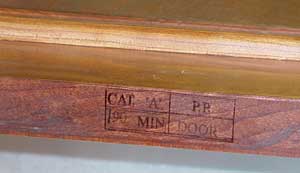Wood Fire-Rated Doors Combine Safety and Aesthetics
Rating Fire Doors
Not all fire doors are created equal. Fire doors are rated by time that a door can withstand exposure to fire conditions. Ratings are given for a door's ability to withstand fire for 1-1/2-hours, 1-hour, 3/4-hour, and 1/3-hour, with the maximum rating required of any swing-type fire door being three hours. Generally speaking, 1/3-hour or 20-minute doors are used for corridors and where smoke and draft control is the main objective. One-hour rated doors are found in between rooms, and 45-minute doors in corridor walls and room partitions. Doors with 1 1/2 hour, or 90-minute ratings, are typically used in stairwells; 3-hour rated doors are typically found in walls that separate buildings or that divide a large building into smaller fire areas.
Up until recently, fire doors have been tested under neutral-or-negative-pressure conditions. But by the year 2000, virtually all of the jurisdictions enforcing the Uniform Building Code (UBC) opted to update to the first model code in the U.S. to require positive-pressure testing of fire doors. Used widely in Europe and Asia, positive pressure testing is intended to more accurately address real-world fire conditions. As air heats up through fire, it expands, causing pressure to build up within an enclosure and increasing the potential impact of fire on a door, and possibly causing flames to enter through cracks or other openings.
The door assembly is placed in a furnace with temperatures up to 1800 º F for the specified length of time. The door must remain latched and in position, with no cracks or openings developing or flame penetrating to the other, non-fire side of the door. After the door has been exposed to the fire for half its intended rating, the door is subjected to a hose stream test, in which it is doused with water from a fire hose. The thermal changes resulting from cold water thrown on a hot surface, combined with the force of the hose stream itself, may cause a door to come unmoored from its frame, not meeting the requirements of the test.
The duration of the hose stream test is dependent on the desired rating of the door. With the positive-pressure testing followed by hose-stream tests, the U.S. has the most stringent standards in the world. In the U.S., fire doors that are rated for 20 minutes are exempt from hose-stream tests.
In certain situations, such as staircase enclosures in a high rise apartment or commercial building, fire doors are called on to resist the transmission of heat so as to give building occupants a safe path of egress to the floors below where the fire is raging. This type of door is known as a temperature rise door, and has a specially designed core to meet these requirements. The fire door label of a temperature rise door will state, not only the door's fire protection rating, but its temperature rise rating above ambient. Typically, these ratings are stated as 250ºF 450ºF, and 650ºF, corresponding to the greatest rise in temperature over and above the temperature measured on the non-fire side of the door during the first half hour of the standard fire test. The highest rating here is the 250ºF as that is the least rise above the ambient temperature.
Relevant Codes and Standards
To be fire rated, all products must have undergone testing at one of the following main certifying laboratories:
Underwriters Laboratory (UL) Certification
UL is the largest and oldest nationally recognized testing laboratory in the United States. Manufacturers submit products to UL for testing and safety certification on a voluntary basis. While there are no laws specifying that a UL Mark must be used, in the U.S. many municipalities have laws, codes or regulations which require a product to be tested by a nationally recognized testing laboratory before it can be sold in their area.
Warnock Hersey Certification
Warnock Hersey is an independent testing laboratory. Building and construction materials bearing the WH Mark indicate product compliance to relevant building codes, association criteria, and product safety and performance standards.
In addition, to be fire rated, products may be subject to other codes and requirements. Some of these include:
American Society for Testing and Materials (ASTM) E2074-Standard test method for fire test of door assemblies
Organized in 1898, ASTM International is one of the world's largest voluntary standards developing organizations. ASTM members, representing producers, users, consumers, government, and academics from over 100 countries, develop technical documents that are a basis for manufacturing, management, procurement, codes, and regulations. There are more than 12,000 ASTM standards that can be found in the 77-volume Annual Book of ASTM Standards.
 |
| Photo courtesy of Artistic Doors & Windows |









